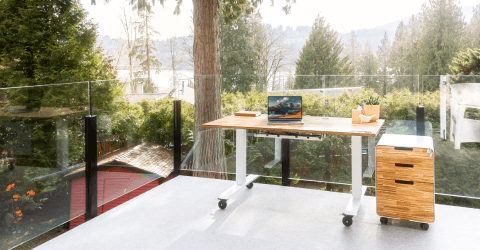
Sustainable Office Furniture: Design That Works for You and Our Planet
Dmytro KlimchukShare
Sustainable office furniture creates spaces where great work and environmental responsibility come together naturally. When you choose eco-friendly materials and thoughtful design for your workspace, you're investing in both personal productivity and a better planet.
At EFFYDESK, we bring Vancouver's deep connection to nature into every piece we create, from our FSC certified wood desks to our ergonomic office chairs made with low chemical emissions.
Why Choose Sustainable Office Furniture?
Let's talk about what really matters in office environments - your comfort and our shared environment.
Traditional furniture production often relies on harmful chemicals and creates significant carbon emissions (did you know a typical office desk's production can generate the same carbon footprint as driving 500 miles?). The materials used, from plastics to steel, often end up as waste when the furniture reaches its end of life.
That's why we focus on sustainable office furniture options that make a real difference. Our approach starts with carefully chosen sustainable materials like reclaimed wood and recycled materials that reduce environmental impact while creating beautiful, durable pieces.
Take our TerraDesk - it turns recycled chopsticks into a stunning, sturdy workspace that improves indoor air quality through natural materials and low chemical emissions. Plus, these sustainable products often outlast conventional furniture, saving you money while cutting down on waste.
Making Smart Choices in Sustainable Office Furniture
Finding truly sustainable office furniture feels exciting when you know what makes a real difference.
Here in Vancouver, where forest stewardship and environmental responsibility shape our daily choices, we've learned what matters.
Look for companies that proudly display Forest Stewardship Council (FSC) certifications and GREENGUARD Gold certified products that ensure better indoor air quality. (Our own journey started right here, inspired by the natural beauty around us!)
Like many West Coast businesses, we believe that sustainable materials deserve full transparency. That's why we're open about using sustainably sourced fabrics, recycled steel, and natural materials throughout our product line.
Many of our office chairs and storage units now incorporate materials that were once destined for landfills, giving them new life while maintaining the style and durability you'd expect from like-new raw materials.
The Evolution of Sustainable Office Design
Modern sustainable office furniture brings fresh thinking to familiar spaces.
We're seeing exciting developments in sustainable products that blend renewable energy use in production with carbon neutral shipping practices. Certified B Corps in our industry now lead the way, showing how furniture manufacturers can balance purpose with profit.
The role of recycled materials keeps growing, especially in home office settings. From desk frames made with recycled steel to office chairs incorporating post-consumer plastics, these materials perform as well as new while reducing carbon emissions.
Our customers often tell us how surprised they are by the premium feel of sustainable furniture - proof that doing good for the environment doesn't mean compromising on quality.
Creating Change Through Better Materials
The sustainable office furniture world keeps getting better through materials innovation. Beyond familiar options like bamboo and wool fabrics, manufacturers now transform waste into wonderful new materials.
Picture tables made from recycled plastics that look like luxury surfaces, or office chairs upholstered in fabrics created from reclaimed ocean waste. Companies with fair trade partnerships ensure these sustainable materials benefit both the environment and the communities producing them.
Our production methods focus on reducing environmental impact at every step. By using renewable energy and optimizing manufacturing processes, we're lowering the carbon footprint of each piece we create.
GREENGUARD Gold certification for our products confirms our commitment to better indoor air quality - essential for spaces where you spend your working hours. The demand for sustainable office furniture shows how businesses and individuals alike want their workspaces to reflect their values.
Building a More Sustainable Future
The journey toward sustainable office environments keeps gaining momentum. From startups to established companies, more businesses recognize that used furniture can find new life through reusing materials and smart refurbishment.
Storage units, chairs, and tables once destined for landfills now return to service looking fresh and performing beautifully.
We're proud to be part of this positive change. Every sustainable option we offer helps move our industry toward a more sustainable future. Whether it's through carbon neutral shipping practices or choosing durable materials that minimize waste, each decision matters.
Creating Your Sustainable Workspace
Your choice of sustainable office furniture does more than just create a beautiful space - it helps build a better planet for all of us. Think about how your workspace can reflect your values while supporting your best work. Our ergonomic office chairs, desks, and other eco-friendly office furniture combine the durability of sustainable materials with designs that inspire creativity and comfort.
Looking to learn more about specific sustainable options for your workspace? Let's chat about finding the perfect balance of style, function, and environmental responsibility for your needs. After all, great work starts with thoughtful choices about where and how we work.